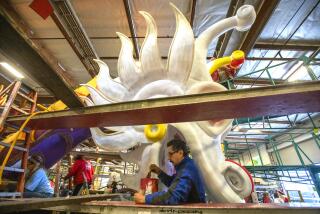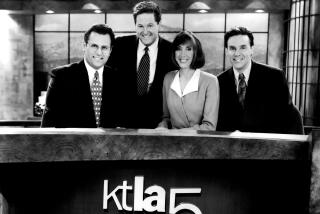The War of the Rose Parades : Television: KTTV drew barbs from rival KTLA and a surge in ratings with its commercial-free coverage. Now KTLA has followed suit.
After watching much of its commanding ratings lead for its coverage of the Tournament of Roses Parade evaporate last New Year’s Day, KTLA Channel 5 has swallowed its pride and some harsh words and will follow arch-rival KTTV Channel 11’s lead in offering a live telecast free of commercial interruptions this Jan. 1.
“They always seem to be playing follow the leader,” quipped Don Tillman, KTTV’s vice president of programming and production, commencing the latest round of sniping and griping over just whose Rose Parade coverage smells the sweetest.
The war of words began about a year ago, when KTTV announced that it would broadcast the 1991 parade “without any commercials whatsoever” and took out ads that knocked KTLA’s commercial-filled telecast. KTLA, which has long held a huge lead in the battle for Rose Parade viewers, retaliated by publicly labeling KTTV’s claim “deceptive and misleading” and “a gimmick” akin to the station’s disastrous 3-D parade broadcast in 1989.
But KTTV’s “gimmick” of announcing sponsors’ names only at the beginning and end of the 2 1/2-hour telecast boosted the station’s Nielsen ratings nearly 40% over the previous year, while KTLA’s numbers fell nearly 25%. In Arbitron, the race was even closer as KTTV’s 1991 telecast attracted 31% of the available viewers, while KTLA grabbed 36%. The previous year, KTLA garnered 46% to KTTV’s 18%.
“They said it was just a gimmick like 3-D, but they must have changed their minds when they saw the ratings,” Tillman said. “I suppose imitation is the sincerest form of flattery.”
“Last year, they went for broke, maybe literally, and they made some progress,” said Steve Bell, KTLA general manager. “When you are the challenger, you have less to lose and you try new things. They pushed the envelope one step further, and so, to basically level the playing field, we had to follow suit.”
Bell stood by KTLA’s characterization of the “commercial-free” tactic as a “gimmick,” and said that KTLA was forced to follow along so that “the gimmick” was no longer the reason viewers decided to chose one station over the other. He predicted that without this disadvantage, KTLA would again win over viewers with what he calls the station’s “Rose Parade tradition” and what it maintains are “the best camera locations” of any station.
He also said that there is no hypocrisy in having called KTTV “misleading and deceptive” last year, then doing the same thing itself this time around. Bell explained that when KTLA complained about KTTV’s claims before the 1991 parade, KTTV was misleading the public. He said that KTTV planned at that point to air radio-like commercial voice-overs for its sponsors during the parade--and that, he said, would have been contrary to KTTV’s “commercial-free” boast.
When the parade actually aired, however, KTTV did no such thing. “When we kicked up a fuss,” Bell said, “they backed off. And I have to compliment them for playing it straight.”
KTTV’s Tillman said that Bell is absolutely wrong, that at no time did KTTV promise its advertisers anything other than what they got during the actual broadcast. All KTTV did during the broadcast was to have the host periodically say something to the effect of: “If you are enjoying this parade without any commercials, you might want to drop a note to (a certain corporation) thanking them for making it possible.” KTLA plans to do the same thing this year.
“What’s going on here is they are having a little trouble eating crow,” Tillman said.
In past years, KTLA aired commercials during the parade by superimposing the logo of its sponsors over part of the screen while the host read a brief ad. Despite the commercial interruption, viewers could still see the parade in the background. This tactic of never leaving the parade for “hard commercials” distinguished both KTLA and KTTV, which also employed this technique in past years, from the three networks, which broadcast the parade nationally with normal commercial interruptions. It was also considered significant in explaining why KTLA and KTTV earned much higher ratings for their parade telecasts than the network-owned stations here.
Though neither Tillman nor Bell would say how much revenue is lost showing the parade without commercials, Bell conceded that “we are both, it seems, in the business of pleasing our audience and not our bottom lines. But television is a competitive business and, when someone gains a competitive edge, all of us are willing to counter it.”
Because of its enormous ratings, the Rose Parade has been one of KTLA’s biggest money-making broadcasts of the year. Bell said that “maybe we won’t earn as much money this year, but whatever it costs us, we’re not going to let anyone take away our dominance in the Rose Parade, now or in the future.”
Bell would confirm only GTE and Honda as having agreed to the new terms of parade sponsorship so far, although he said that deals with several other companies are pending. KTTV said that Miller Brewing Co., Hyundai, Lincoln Mercury, Carl’s Jr. and American Savings have signed up to sponsor Channel 11’s telecast.
KTTV will repeat the telecast without commercials immediately following the conclusion of the live broadcast at 10:30 a.m., and then will air it three more times throughout the day with commercials edited into the program. KTLA will also repeat the parade with commercials three times on New Year’s Day.
The parade will also air live at 8 a.m. on Channels 2, 4 and 7 and on Spanish-language station KMEX Channel 34.
More to Read
The complete guide to home viewing
Get Screen Gab for everything about the TV shows and streaming movies everyone’s talking about.
You may occasionally receive promotional content from the Los Angeles Times.






